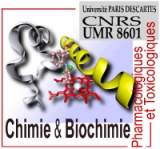AuPosSOM
Welcome!
AuPosSOM is a free virtual screening tool for the automatic analysis of docked structures.
The on-line version of AuPosSOM 2.1 is available !The analysis of contacts takes into account hydrogen-bonds / Coulombic / hydrophobic / all contacts between drugs and protein.
A scoring function to identify putative active compounds in a tree has been developed. Filters are also available to remove non-specific contacts and different types of contacts can be fused in a same analysis.
Go here to create an account. Feel free to contact usfor any problems or suggestions.
NEWS
- AuPosSOM version 2.0 was presented for the first time by our colleague A. Mansyzov at the JOBIM congress at Pasteur Institute (Paris) in june 2011. Abstract: (pdf) JOBIM : site (in french).
- Tips and tricks: preAuPosSOM: a simple toolbox to make the complexes (Special thanks to A. Sakhteman)
References to cite
The AuPosSOM team:
Bouvier G
Mantsyzov AB
Melikian M
Girault JP
Bertho G*
Related publications
- Reviews
Protein-Ligand Docking in the Machine-Learning Era.
Yang C, Chen EA, Zhang Y.Molecules. 2022 Jul 18;27(14):4568. doi: 10.3390/molecules27144568. PMID: 35889440 Review.
- Structure-Based Virtual Screening for Drug Discovery: a Problem-Centric Review Cheng, T., Li, Q., Zhou, Z., Wang, Y., & Bryant, S. H. (2012). The AAPS journal, 14, 133-141.
- Examples of applications
Pacheco DF, Alonso D, Ceballos LG, Castro AZ, Brown Roldán S, García Díaz M, Villa Testa A, Wagner SF, Piloto-Ferrer J, García YC, Olea AF, Espinoza L.Int J Mol Sci. 2022 Aug 7;23(15):8775. doi: 10.3390/ijms23158775. PMID: 35955909
Calzada F, Bautista E, Hidalgo-Figueroa S, García-Hernández N, Velázquez C, Barbosa E, Valdes M, Solares-Pascasio JI.Pharmaceuticals (Basel). 2022 Feb 3;15(2):196. doi: 10.3390/ph15020196. PMID: 35215308
Zhang J, Liu Z, Zhao W, Yin X, Zheng X, Liu C, Wang J, Wang E.Front Pharmacol. 2022 Jan 5;12:797821. doi: 10.3389/fphar.2021.797821. eCollection 2021. PMID: 35069209
Machine Learning-Enabled Pipeline for Large-Scale Virtual Drug Screening.
Gupta A, Zhou HX.J Chem Inf Model. 2021 Sep 27;61(9):4236-4244. doi: 10.1021/acs.jcim.1c00710. Epub 2021 Aug 17. PMID: 34399578
Lung J, Hung MS, Lin YC, Hung CH, Chen CC, Lee KD, Tsai YH.Molecules. 2020 Nov 13;25(22):5293. doi: 10.3390/molecules25225293. PMID: 33202823
Prospects of Indole derivatives as methyl transfer inhibitors: antimicrobial resistance managers.
Tha S, Shakya S, Malla R, Aryal P.BMC Pharmacol Toxicol. 2020 May 4;21(1):33. doi: 10.1186/s40360-020-00402-9. PMID: 32366298
Palos I, Lara-Ramirez EE, Lopez-Cedillo JC, Garcia-Perez C, Kashif M, Bocanegra-Garcia V, Nogueda-Torres B, Rivera G.Molecules. 2017 Jun 18;22(6):1015. doi: 10.3390/molecules22061015. PMID: 28629155
Interaction of a small molecule Natura-α and STAT3-SH2 domain to block Y705 phosphorylation and inhibit lupus nephritis Chiao JW, Melikian M, Xue C, Tsao A, Wang L, Mencher SK, Fallon J, Solangi K, Bertho G*, Wang LG* Biochem Pharmacol. (2015) Nov 28. pii: S0006-2952(15)00746-7. doi: 10.1016/j.bcp.2015.11.018
- In silico identification and evaluation of new Trypanosoma cruzi trypanothione reductase (TcTR) inhibitors obtained from natural products database of the Bahia semi-arid region (NatProDB). da Paixão VG, Pita SSDR. Comput Biol Chem. (2019) Apr;79:36-47. doi: 10.1016/j.compbiolchem.2019.01.009
Binding mode of triazole derivatives as aromatase inhibitors based on docking, protein ligand interaction fingerprinting, and molecular dynamics simulation studies. Mojaddami A, Sakhteman A, Fereidoonnezhad M, Faghih Z, Najdian A, Khabnadideh S, Sadeghpour H, Rezaei Z. Res Pharm Sci. (2017) 1, 21-30
A Comparative QSAR Analysis, Molecular Docking and PLIF Studies of Some N-arylphenyl-2, 2-Dichloroacetamide Analogues as Anticancer Agents. Iran J Pharm Res. (2017) 16(3):981-998
- Integrative computational protocol for the discovery of inhibitors of the Helicobacter pylori nickel response regulator (NikR) Segura-Cabrera A, Guo X, Rojo-Domínguez A, Rodríguez-Pérez MA. (2011) J Mol Model. Mar 1. [Epub ahead of print]
- Discovery of novel anti-leishmanial agents targeting LdLip3 lipase. Parameswaran, S., Saudagar, P., Dubey, V.K., Patra, S. 2014. Journal of Molecular Graphics and Modelling
- Screening natural products database for identification of potential antileishmanial chemotherapeutic agents Venkatesan S. K., Saudagar P., Shukla A. K., Dubey V. K. (2011) Interdiscip Sci. 3, 217-31
- Footprinting of Inhibitor Interactions of in silico identified inhibitors of trypanothione reductase of Leishmania parasite Venkatesan, S. K., & Dubey, V. K. (2012). The Scientific World Journal, Epub 2011 Nov 2
- In silico-based identification of human α-enolase inhibitors to block cancer cell growth metabolically. Drug Des Devel Ther. (2017) 11:3281-3290
- Leishmania infantum 5'-Methylthioadenosine Phosphorylase presents relevant structural divergence to constitute a potential drug target. Abid H, Harigua-Souiai E, Mejri T, Barhoumi M, Guizani I. BMC Struct Biol. 2017 Dec 19;17(1):9. doi: 10.1186/s12900-017-0079-7.
